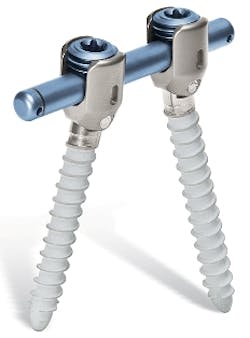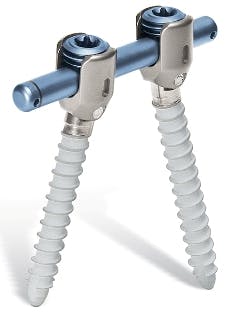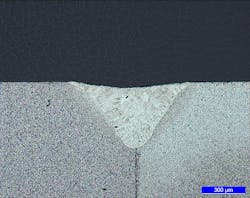Laser welding processes validated at SLV Institute
Munich, Germany - Peter Limley, medical device specialist at the SLV Welding Training and Research Institute, is used to offering external support to companies developing and validating demanding laser welding processes. Recently, Limley has been validating welds with Rofin lasers on Ulrich Medical's new generation of screws for dynamic stabilization of the spine.
The fundamental part of the Ulrich's cosmicTM concept is a hinge joint between the bolt head and the thread. To increase the precision and safety of screwing implants into vertebrae, Ulrich Medical canulates the screws, i.e., it applies a central drill hole. In this way, the position and the angle of the screw channel can initially be fixed with a thin guide wire, allowing precision positioning of the screw.
Hollow-drilled cosmicTM screws as an alternative for dynamic spine stabilization.
Official approval of the implants in the medical device industry calls for redundancy safeguards for central body functions. The press fit of the two intricate bolts (with a diameter of 1.5 mm and a length of 3 mm) connecting the screw with the half-shell is not sufficient so a laser weld acts as a redundancy safeguard to protect against the parts becoming loose. All parts are made of a titanium alloy. In addition, a small gap has to be welded – as the drill holes are a slightly larger diameter – to act as an assembly aid for insertion of the bolts.
The welding process
A range of Rofin lasers is available at SLV Munich, including the Integral and Performance, which are designed to be used as manual machines and can also be run as CNC-controlled laser welding systems. After putting the components into the fixture, the CNC-controlled welding process creates the required circular seam weld. Limley sets and refines the relevant values for the voltage, pulse width and pulse energy to ensure that during in-house testing, the workpiece has a penetration depth of 0.4 mm without any micro-cracking or other weld defects. The laser parameters create a seam weld that is approx. 500 microns wide.
Metallographic evaluation for validation
The first step of metallurgical evaluation of the weld is conducted by taking cross sections. Looking through the microscope, the ground and polished cross-sectioned surface allows the exact identification of the position and depth of the weld; as well as any structural modification of the material. Additionally, the evaluation of various test samples demonstrates the process reliability and component variation.
Finally, tests establish the increase in material hardness at the weld seam compared to the hardness in the base material. The metallographic evaluation of the samples produced at Ulrich Medical and tested by SLV Munich show consistent welding results and no defects, an important prerequisite for the approval of the new screws.
The hollow-drilled cosmic screws have become established as an alternative solution for the dynamic stabilization of the spinal column. Rofin's new Integral with 200 watts at the SLV Munich has become suited for welding of complex materials and material combinations such as aluminum and copper.
For more information, email Susanne Lötzsch, Rofin Baasel Lasertech at [email protected] or Peter Limley, SLV München at [email protected].


